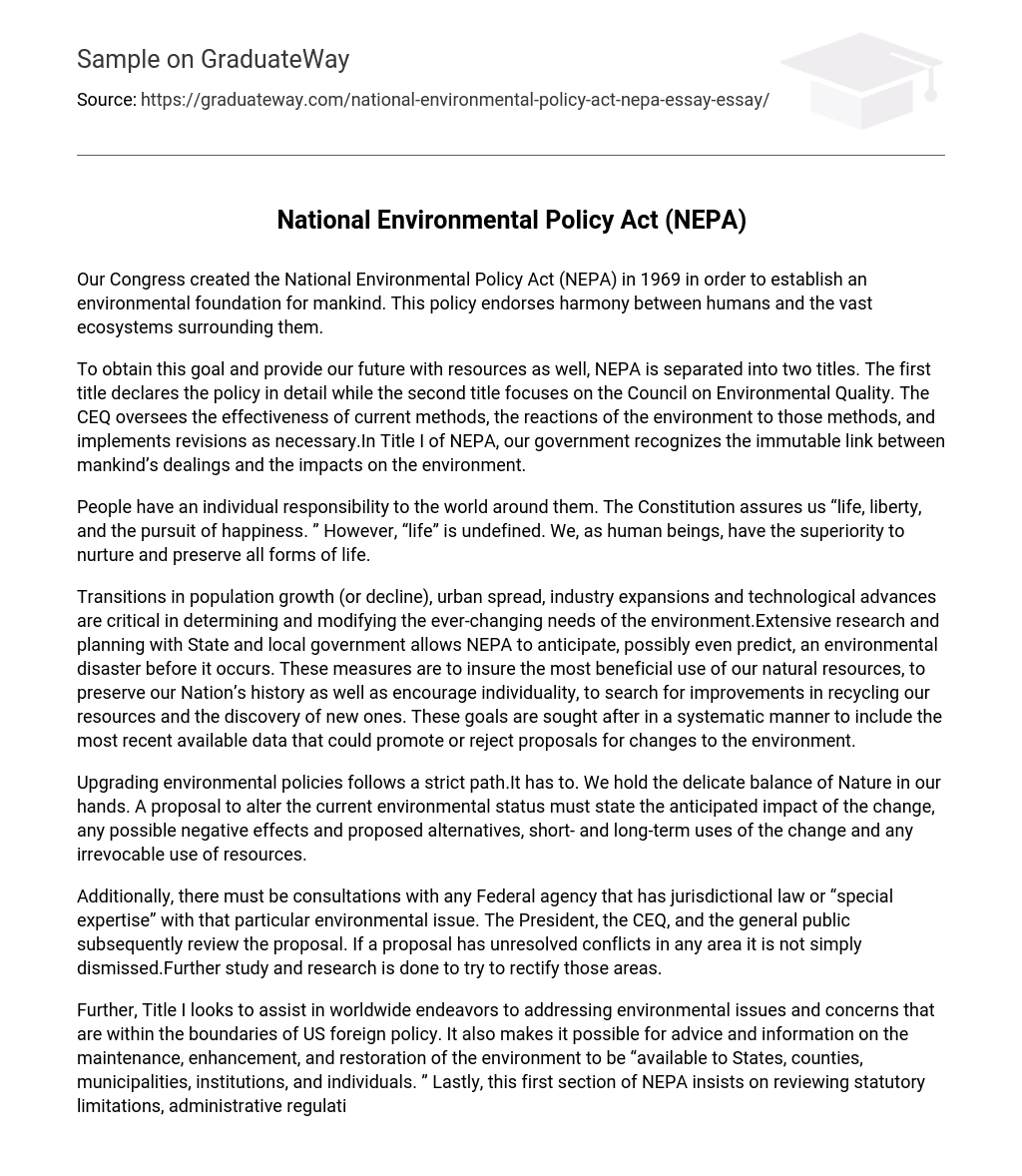The National Environmental Policy Act (NEPA) was introduced by our Congress in 1969 with the aim of creating an environmental foundation for mankind. Its goal is to foster a harmonious relationship between humans and the vast ecosystems that surround them.
In order to accomplish this goal and conserve resources for future generations, the National Environmental Policy Act (NEPA) is divided into two sections. The first section provides a detailed overview of the policy, while the second section centers around the Council on Environmental Quality (CEQ). CEQ’s responsibilities include evaluating the effectiveness of current practices, assessing their environmental effects, and making any necessary changes. In Title I of NEPA, the government recognizes the interconnectedness between human actions and their impact on the environment.
Every individual has a duty to the world they live in. Our rights to “life, liberty, and the pursuit of happiness” are protected by the Constitution, yet the exact meaning of “life” is uncertain. As people, we have the ability to nurture and protect all forms of life.
Population growth (or decline), urban spread, industry expansions, and technological advances are significant factors influencing the constantly evolving environmental requirements. By collaborating with State and local government in thorough research and planning, NEPA possesses the capability to foresee and anticipate potential environmental catastrophes ahead of time. The purpose of these measures is to guarantee the best possible utilization of our natural resources, safeguard our nation’s history, foster individuality, encourage advancements in recycling existing resources, and facilitate the exploration of new ones. These objectives are pursued systematically by integrating the most up-to-date data to either endorse or dismiss proposals for environmental modifications.
Upgrading environmental policies is a rigorous process that must be followed due to our responsibility for maintaining the fragile balance of Nature. Any proposal to modify the current environmental status should clearly outline the expected consequences of the change, acknowledge any potential adverse effects, present alternative options, consider both short- and long-term implications, and address any irreversible use of resources.
In addition, consultations must take place with any Federal agency that has jurisdictional law or “special expertise” in the specific environmental issue. The proposal is then reviewed by the President, the CEQ, and the general public. If there are any unresolved conflicts in any aspect of the proposal, it is not immediately disregarded. Instead, further study and research are conducted to address and resolve those areas.
Title I of NEPA aims to support global efforts in addressing environmental issues and concerns that fall within US foreign policy boundaries. It also enables the provision of guidance and knowledge regarding the preservation, improvement, and restoration of the environment to various entities including States, counties, municipalities, institutions, and individuals. Additionally, this initial part of NEPA emphasizes the need to regularly assess statutory restrictions, administrative rules, and current practices to continuously align with environmental well-being objectives. It serves as a frequent complement to existing environmental legislations.
Title II of NEPA focuses on the Council on Environmental Quality (CEQ) which aims to ensure environmental agencies comply with NEPA and keep the President informed about environmental concerns. The CEQ chairman, appointed by the President, is responsible for submitting an annual Environmental Quality Report. This report provides an overview of terrestrial areas (forests, wetlands, urban and rural settings), marine habitats, freshwater habitats, estuary habitats, and air quality. It also includes data on resource quality, management patterns, utilization patterns, and their resulting impacts on the environment.
Implementing policies or laws on the environment has social, economic, and global impacts. The CEQ Report assesses these policies and regulations to enhance our environmental utilization. Discovering flaws in our policies earlier allows for increased efficiency. To fulfill their responsibilities, the CEQ must collaborate with experts in science, agriculture, industry and labor, conservation, as well as local and State governments.
The Council has partnerships with various organizations, including public, private, and individual entities, in order to achieve two objectives: 1) obtaining comprehensive, up-to-date, and concise information about the state of the environment and 2) avoiding duplication of existing programs or policies. The subsequent sections of Title II detail the allocation of salaries and funds for improvement. The Council is authorized to hire a maximum of ten specialists or experts to gather the most advanced environmental statistics or data. Included within these funds is an Office of Environmental Quality management Fund.
The purpose of this fund is to research and study potential agreements that are jointly sponsored by the Office and one or more other Federal agencies. The Chairman of the CEQ is responsible for distributing the fund and establishing operating regulations. In general, the implementation of NEPA has enabled people to stay informed and engage in environmental discoveries and changes. This has resulted in international concerns and endeavors to enhance our environment.
Canada, Mexico, and the US signed a Memorandum of Understanding (MOU) in September 1992 to strengthen cooperation in environmental development and education throughout North America. These efforts aim to reiterate our dedication to the environment and acknowledge its importance in meeting human needs and preserving the welfare of animals, birds, trees, open land, fish, and plants.
Two exceptions disrupt the absence of physical voice – the compassionate voice of mankind and the voice of extinction.





